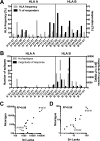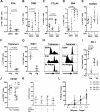Immunodominant Dengue Virus-Specific CD8+ T Cell Responses Are Associated with a Memory PD-1+ Phenotype
- PMID: 26912627
- PMCID: PMC4836325
- DOI: 10.1128/JVI.02892-15
Immunodominant Dengue Virus-Specific CD8+ T Cell Responses Are Associated with a Memory PD-1+ Phenotype
Abstract
Dengue disease is a large public health problem that mainly afflicts tropical and subtropical regions. Understanding of the correlates of protection against dengue virus (DENV) is poor and hinders the development of a successful human vaccine. The present study aims to define DENV-specific CD8(+)T cell responses in general and those of HLA alleles associated with dominant responses in particular. In human blood donors in Nicaragua, we observed a striking dominance of HLA B-restricted responses in general and of the allele B*35:01 in particular. Comparing these patterns to those in the general population of Sri Lanka, we found a strong correlation between restriction of the HLA allele and the breadth and magnitude of CD8(+)T cell responses, suggesting that HLA genes profoundly influence the nature of responses. The majority of gamma interferon (IFN-γ) responses were associated with effector memory phenotypes, which were also detected in non-B*35:01-expressing T cells. However, only the B*35:01 DENV-specific T cells were associated with marked expression of the programmed death 1 protein (PD-1). These cells did not coexpress other inhibitory receptors and were able to proliferate in response to DENV-specific stimulation. Thus, the expression of particular HLA class I alleles is a defining characteristic influencing the magnitude and breadth of CD8 responses, and a distinct, highly differentiated phenotype is specifically associated with dominant CD8(+)T cells. These results are of relevance for both vaccine design and the identification of robust correlates of protection in natural immunity.
Importance: Dengue is an increasingly significant public health problem as its mosquito vectors spread over greater areas; no vaccines against the virus have yet been approved. An important step toward vaccine development is defining protective immune responses; toward that end, we here characterize the phenotype of the immunodominant T cell responses. These DENV-reactive T cells express high levels of the receptor programmed death 1 protein (PD-1), while those from disease-susceptible alleles do not. Not only does this represent a possible correlate of immunodominance, but it raises the hypothesis that PD-1 might be a regulator that prevents excessive damage while preserving antiviral function. Further, as this study employs distinct populations (Nicaraguan and Sri Lankan donors), we also confirmed that this pattern holds despite geographic and ethnic differences. This finding indicates that HLA type is the major determinant in shaping T cell responses.
Copyright © 2016, American Society for Microbiology. All Rights Reserved.
Figures




References
-
- Bhatt S, Gething PW, Brady OJ, Messina JP, Farlow AW, Moyes CL, Drake JM, Brownstein JS, Hoen AG, Sankoh O, Myers MF, George DB, Jaenisch T, Wint GR, Simmons CP, Scott TW, Farrar JJ, Hay SI. 2013. The global distribution and burden of dengue. Nature 496:504–507. doi:10.1038/nature12060. - DOI - PMC - PubMed
-
- Gubler DJ. 1997. Dengue and dengue hemorrhagic fever: its history and resurgence as a global public health problem, p 1–22. In Gubler DJ, Kuno G (ed), Dengue and dengue hemorrhagic fever. CAB International, New York, NY.
-
- Innis BL. 1997. Antibody responses to dengue virus infection, p 221–243. In Gubler DJ, Kuno G (ed), Dengue and dengue hemorrhagic fever. CAB International, New York, NY.
-
- WHO. 2009. Dengue: guidelines for diagnosis, treatment, prevention and control: new edition. WHO, Geneva, Switzerland. - PubMed
Publication types
MeSH terms
Substances
Grants and funding
LinkOut - more resources
Full Text Sources
Other Literature Sources
Medical
Research Materials

